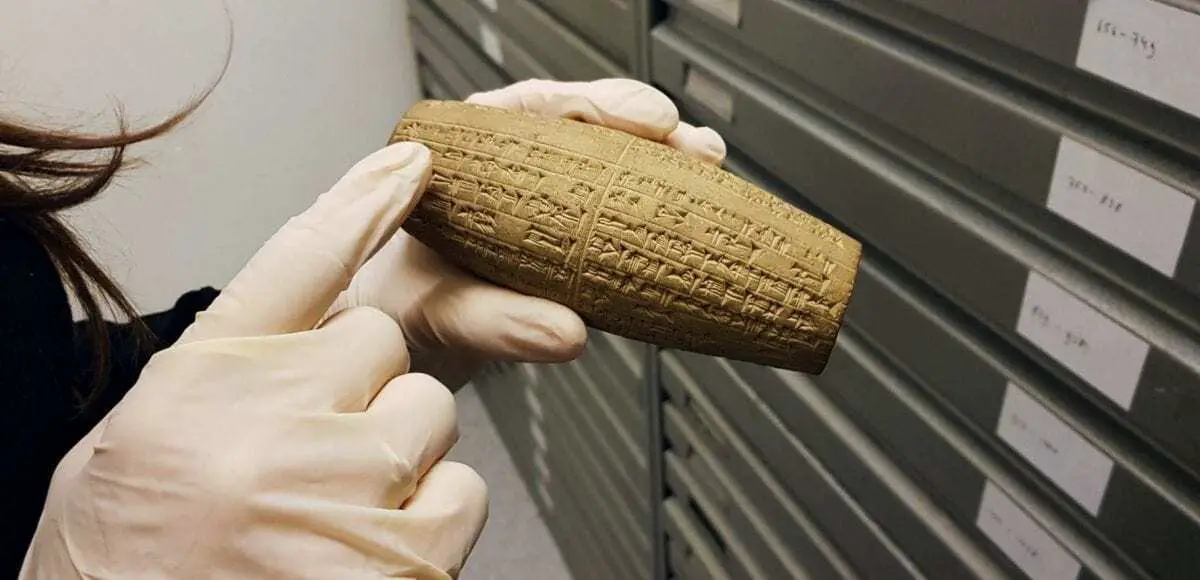Assyriologists in Leiden have been conducting research into ancient clay tablets from the Middle East for 100 years already. What exactly do these clay tablets tell us? And why is Leiden such a good place to study them?
Professor of Assyriology Caroline Waerzeggers strides through the library of the Netherlands Institute for the Near East (NINO), dodging past students and bookshelves, before she comes to a sudden halt at a safe door. She fiddles with the lock, the thick door slides open and she enters a room not much bigger than a toilet.
The room may be small, but the cabinets contain a veritable treasure trove of academic information. This is the Böhl collection, a collection of 3,000 clay tablets ranging in age from 2,500 to 4,000 years old. Some of the tablets are the size of a bathroom tile, but most are not much bigger than a thumbnail.
‘It’s amazing to have such a fabulous collection,’ says Waerzeggers, as she picks up the odd clay tablet. Small lines have been etched into the tiles, as if someone has doodled stick men on them. In fact, this is cuneiform, a system of writing that people in the Middle East used to communicate with one another long before Christ was born. ‘The best way to learn this difficult writing system is to use real clay tablets. That’s why working with this collection is so valuable to our students.’
Back to the Tigris and Euphrates
Assyriology is the discipline that looks at these clay tablets and the cuneiform etched upon them. Cuneiform was used for a not inconsiderable 3,000 years in the Middle East, and many clay tablets are well preserved, offering a wealth of information about a period in which society fundamentally changed as new forms of state, religions and literature emerged. They transport you back to Mesopotamia and the fertile river system of the Tigris and the Euphrates.
The chair in Assyriology at Leiden is over 100 years old: the first professor of Assyriology was appointed in 1918. To mark this centenary, a conference is being held on 13 December with leading Assyriologists from Paris, Tel Aviv, Copenhagen, Heidelberg and New York.
Centre of the discipline
It all began in 1918 with Professor Gerard Jacobus Thierry, who specialised in the Old Testament and biblical languages such as Hebrew and Aramaic. He viewed his research through a very theological lens: alongside professor he was a minister for the Dutch Reformed Church. Assyriology wasn’t his prime concern. ‘I prefer to teach the language of Isaiah [an Old Testament prophet] than that of Sennacherib [an Assyrian king],’ he is supposed to have said.
This all changed in 1927, when Leiden gained an Austrian professor of Assyriology, with the mellifluous name of Franz Marius Theodor de Liagre Böhl, the namesake of the clay tablet collection. ‘You could say that that is when the Leiden school really began,’ says Waerzeggers. ‘Böhl was really good at conveying his fascination for the Promised Land and the clay tablets to his students and the general public. The press followed his every move. He could enthral people with his knowledge and was very charismatic. When he travelled to Egypt, he convinced the pilot of the plane to circle the pyramids at Gizeh one more time.’
In the decades that followed, Leiden earned a reputation as a centre for the study of cuneiform. And thanks in part to the good library and collaboration with the National Museum of Antiquities, the city is still one of the top in the discipline. Leiden University organises Rencontre Assyriologique Internationale conference once every ten years, an honour that otherwise is only bestowed on Paris. Waerzeggers: ‘Leiden has earned a permanent place in the spotlight, particularly when it comes to international collaboration. Both at home and abroad, Leiden is seen as one of the centres for our discipline.’
Not a mere curio
However, the future is not always certain, says Waerzeggers when we are back in her office. ‘A discussion is raging about whether Dutch universities offer too many small degree programmes. And Assyriology of all programmes is often used as the proverbial example of this. It sometimes seems as though people think we’re odd bods or über nerds with no relevance to society. But cuneiform isn’t a curio. It was used for longer than the current era.’
She means that there is so much more to study. The Assyriologists at Leiden like to seek connections with other disciplines. They like to use the technical knowhow of Delft University of Technology, for instance. Some time ago, they passed various clay tablets through a micro-CT scanner. These clay tablets are packed in a sealed envelope of clay, which means they can’t be read. Thanks to the CT-scan, the Assyriologists were able to get to the valuable information without opening the envelope. There are also plans to identify the authors of clay tablets by means of the fingerprints that they left behind in the clay.
‘Assyriology can also be of great value to Dutch education,’ Waerzeggers philosophises aloud. ‘Nowadays it’s all about the clash between people from different cultures and religions. In Mesopotamia, we have a shared birthplace of Europe and the Middle East.’
Written by Merijn van Nuland – Leiden University
Header Image Credit : Merijn van Nuland







